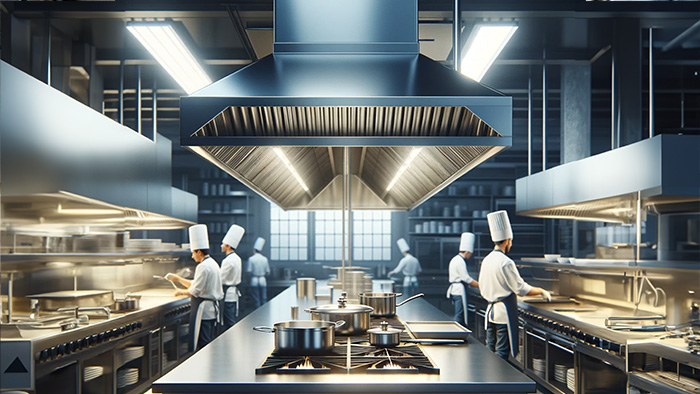
In the bustling environment of commercial kitchens, the commercial exhaust canopy emerges as an indispensable component, pivotal in maintaining air quality and ensuring a safe, comfortable working atmosphere. This comprehensive guide dives into the essence, varieties, and critical considerations surrounding commercial exhaust canopies, interspersed with practical insights, visual illustrations, and external resources to equip you with a thorough understanding of these vital systems.
Key Takeaways
- Commercial exhaust canopies are essential for extracting smoke, heat, and grease from kitchen air, promoting a healthier working environment.
- They vary in types, such as wall-mounted and island canopies, each tailored to specific kitchen layouts and needs.
- Proper installation and sizing are crucial for effectiveness and compliance with safety regulations.
Commercial exhaust canopies, also known as kitchen hoods, are designed to remove airborne contaminants like smoke, grease, and heat from commercial kitchens. They play a critical role in fire prevention, air purification, and temperature control, making them a non-negotiable fixture in any food preparation area.
• Wall-mounted Canopies
These are installed against the kitchen wall, above the cooking appliances. Ideal for kitchens with limited space or where cooking appliances are lined along the walls.
• Island Canopies
Suspended from the ceiling and accessible from all sides, island canopies are perfect for central cooking areas in larger kitchens.
Installation should always be conducted by professionals to ensure compliance with local regulations and optimal functionality. Maintenance involves regular cleaning and inspection to prevent grease buildup, which can pose a fire hazard.
The size of the exhaust canopy should correspond to the size and type of cooking equipment it serves. An improperly sized canopy can lead to inefficient operation and increased risk of fire.
When selecting a commercial exhaust canopy, consider factors such as the size of your kitchen, the type and volume of cooking, and local health and safety regulations. It's also important to think about ease of cleaning, noise levels, and energy efficiency.
Modern exhaust canopies come equipped with features like variable speed fans and heat recovery systems, reducing energy consumption and contributing to a more sustainable operation.
Adhering to national and local regulations is paramount when installing an exhaust canopy. These regulations often dictate the canopy's size, installation height, and fire suppression systems.
It's crucial to ensure that your exhaust canopy is installed with adequate clearance from combustibles, following NXT GEN Canopies guidelines and local codes.
Determining the correct size for your kitchen's exhaust hood system is essential for efficient operation.
Professional installation ensures that your exhaust canopy functions efficiently, safely, and in compliance with all regulations. Regular maintenance, including cleaning and inspections, is crucial to prevent grease accumulation and ensure the longevity and safety of your exhaust system.
In the ever-evolving landscape of commercial kitchens, the exhaust canopy stands as a guardian of health, safety, and efficiency. By understanding the types, installation considerations, and maintenance requirements of these systems, kitchen operators can ensure a safer, more comfortable working environment for their teams and comply with stringent health and safety standards.